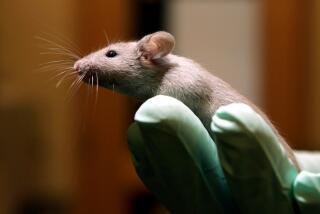Hope for the balding? Scientists trigger new hair growth
- Share via
In a feat that may provide hope to men and women who suffer from hair loss, researchers said they had successfully grown hair follicles in human flesh using implanted donor cells.
While rodents have the ability to regenerate lost hair, scientists have so far been unable to trigger re-growth in humans. Instead, they traditionally treat hair loss by removing hair follicles from the back of a patient’s head and transplanting them to another area of the scalp.
Now, in a study published Monday in the journal PNAS, researchers used lab methods to simulate the behavior of rodent cells in order to induce hair growth in human flesh.
“Although further work will be required to increase the efficiency of this process, this crucial first step represents a milestone advance for bioengineering of human hair,” the authors concluded.
The researchers took donated dermal papillae cells and cultured them in the lab so that they clustered together in the shape of a ball. In past failed experiments, the donor cells had been grown on a flat surface.
Researchers hypothesized that since rodent cells clump together in spherical shapes prior to new hair growth, human cells might be more likely to sprout hair if they were similarly clustered.
The researchers surmised that by growing the cells on a flat surface, they were robbing the cells of their ability to pick up on and communicate cellular “cues” necessary for regeneration.
To test their hypothesis, scientists took the donated cells, which grow at the base of hair follicles, and cultured them in the lab so that they formed spheres.
Next, they took the circumcised foreskin of infants and implanted the cultured dermal papillae into the tissue. The foreskins were then grafted onto the backs of lab mice, according to researchers. In five of seven tests, the transplants resulted in new hair growth, authors said.
The scientists used neonatal foreskin for their experiment because it does not naturally have hair follicles. If hair did grow within the graft, it would demonstrate that the implanted cells had helped to “reprogram the recipient epidermis to a follicular fate,” authors wrote.
“This method offers the possibility of inducing large numbers of hair follicles or rejuvenating existing hair follicles, starting with cells grown from just a few hundred donor hairs,” said study coauthor Angela Christiano, an associate professor of molecular dermatology at Columbia University Medical Center.
“It could make hair transplantation available to individuals with a limited number of follicles, including those with female-pattern hair loss, scarring alopecia, and hair loss due to burns,” Christiano said in a statement.
Colin Jahoda, a study coauthor and professor of stem cell sciences at Durham University in Britain, said more work needed to be done before the method could be performed on humans. However, he said the results were very encouraging.
“This study is an important step toward the goal of creating a replacement skin that contains hair follicles for use with, for example, burn patients,” he said.







